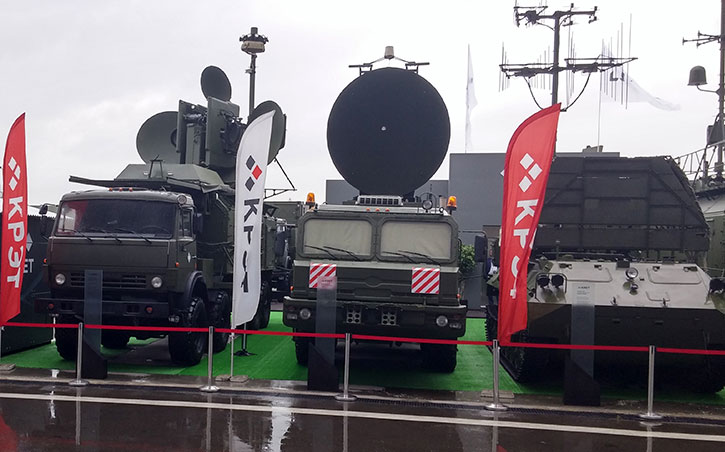
Probing the Effects Electronic Attack
Another level of military assistance provided by the Russians in Syria is Electronic Support – among the systems the Russian forces deployed to Syria were the Tu-214R electronic surveillance aircraft. The Russian Air Force also deployed IL20M1 surveillance aircraft equipped with SAR and SIGINT sensors to provide wide area surveillance over a radius of 300 km. On the ground, the Russians deployed tactical mobile jammers capable of disrupting communications activity at ranges of 10-15 km. Larger EW systems mounted on 8×8 trucks were also deployed in theater.
The Russian army operates the Krasukha Electronic Warfare units in support of short range missiles (such as SS-26 Iskander) and long-range surface to air missile (SAM) units (S-400). The system is developed and built by the Gradient plant of the KRET electronics group.
The system comprises several types of mobile units mounted on 8×8 BAZ-6910-022 trucks. Krashuka-2 are used specifically against airborne early warning and Control (AWACS). The Krasukha 4 broadband multi purpose electronic warfare systems.
Krashuka-4 operates high power jammers in the VHF/UHF and higher wavebands, against radar systems and communication links supporting reconnaissance aircraft, unmanned aircraft (UAVs) and satellites in Low Earth Orbit. According to Russian sources, one of the techniques employed by the system is disrupting enemy capability to carry out precision attacks by denying adversary aircraft and missiles from obtaining target positions and location updates.
According to western sources, these systems were instrumental in masking the tracks of the insertion of Russian air power in Syria (Krashuka-4 units were spotted at Hmeimim soon after the first deployments). Coalition air forces have also encountered heavy interruptions to location signals transferred from airborne and land based command posts to attack aircraft, causing repeated mission aborts.
Summary
The Russians position their involvement in the Syrian conflict as support of an allied nation in distress. The Russian opted their intervention to be in wide scale, decisive manner, in which they were determined to come victorious and the most benefit of their investment.
Apart from supporting their allies, for the Russian air force, the deployment of first line air- and ground based air defense units to a combat theater provided unprecedented benefits. It is the fact they can track the latest types of adversary weapons – F-22, B-1, Typhoon, Patriot and SAMP/T air defense systems and unmanned aerial systems (UAS) as well as soon to arrive F-35 (Israeli or American). The Russian presence in Syria, on the ground and in the air, enables their expert teams to test and evaluate advanced electronic reconnaissance and combat systems against them. They are also busy obtaining measurement and signature intelligence (MASINT) against potential adversary platforms operating in combat deployment. A nice side benefit is the differentiation and promotion of battle proven weapon systems made in Russia, a trend that is already having traction – new sales of Su-34, 35, Mi-28NE, Ka-52, BMPT, S-400, Tosh and Pantsir S1 – were all reported in 2017.















